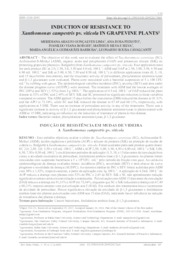Induction of resistance to Xanthomonas campestris pv. viticola in grapevine plants.
Induction of resistance to Xanthomonas campestris pv. viticola in grapevine plants.
Author(s): LIMA, M. A. G.; PEIXOTO, A. R.; BORGES, I. V.; SILVA, M. S. e; BARBOSA, M. A. G.; CAVALCANTI, L. S.
Summary: The objective of this work was to evaluate the effect of Saccharomyces cerevisiae (SC), Acibenzolar-S-Methyl (ASM), organic acids and polyphenols (OAP) and potassium silicate (SiK) on protecting grapevine plants (cv. Redglobe) from Xanthomonas campestris pv. viticola. Four application rates for each product (SC at 2.0, 2.50, 3.0, 3.50 and 4.0 mL 100 L-1; ASM and OAP at 2.50, 3.00, 3.50, 4.50 and 6.00 mL 100 L-1 and SiK at 5.00, 6.50, 7.50 and 8.50 mL 100 L-1) in different application times (0, 5, 10, and 15 days before inoculation), and the enzymatic activity of peroxidases, phenylalanine ammonia-lyase and ?-1,3 glucanases were evaluated. Plants were inoculated with a bacterial suspension of 5 x 108 CFU mL-1 by rubbing with gauze. The epidemiological variables incidence (INC), severity (SEV) and area under the disease progress curve (AUDPC) were assessed. The treatment with ASM had the lowest averages of INC (38%) and SEV (1.52%) from 3 g 100 L-1. The application of 4.5 mL 100 L-1 of OAP reduced the plant disease in 52% of INC and 2.45% of SEV. SiK and SC presented no significant reduction in these variables compared to control. The ASM applied 15 days before the inoculation (DBI) reduced the disease in 91.31% and the APO in 73.34%, while SC and SiK reduced the disease in 67.49 and 60.11%, respectively, with applications at 5 DBI. There was no increase of peroxidase activity in any of the treatments. There was a significant increase in activity of ?-1,3 glucanases and phenylalanine ammonia-lyase in plants treated with ASM at 15 DBI, indicating an influence on the induction of resistance of plants to this disease.
Publication year: 2017
Types of publication: Journal article
Unit: Embrapa Semi-arid Region
Observation
Some of Embrapa's publications are published as ePub files. To read them, use or download one of the following free software options to your computer or mobile device. Android: Google Play Books; IOS: iBooks; Windows and Linux: Calibre.
Access other publications
Access the Agricultural Research Database (BDPA) to consult Embrapa's full library collection and records.
Visit Embrapa Bookstore to purchase books and other publications sold by Embrapa.

